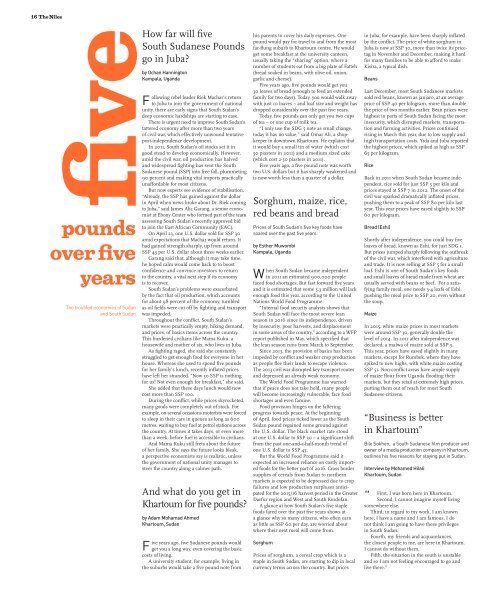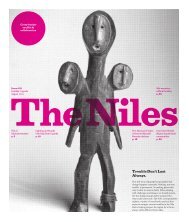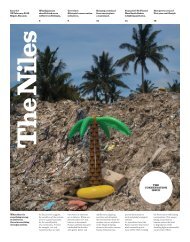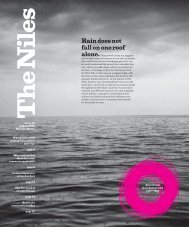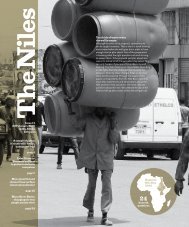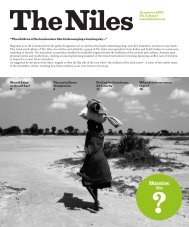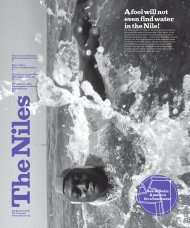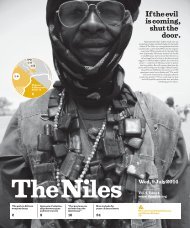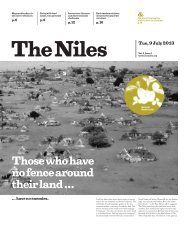Enter houses through their doors...
...suggests an old Sudanese saying. This image, taken five years ago of a man clambering over a fence to view the debut football match of South Sudan’s national team, shows how you can just as easily take an unorthodox route. Over the past five years, both Sudan and South Sudan have taken a few unexpected detours. To mark the five-year anniversary of the separation of the Sudans, The Niles correspondents from both countries have taken a closer look at the paths taken by the neighbouring states. Many developments are sobering, but a few offer scope for hope. In any case, the idiom on the cover of the first print edition of The Niles, published five years ago today, rings truer than ever: It is a fool who rejoices, when the neighbour is in trouble.
...suggests an old Sudanese saying. This image, taken five years ago of a man clambering over a fence to view the debut football match of South Sudan’s national team, shows how you can just as easily take an unorthodox route. Over the past five years, both Sudan and South Sudan have taken a few unexpected detours. To mark the five-year anniversary of the separation of the Sudans, The Niles correspondents from both countries have taken a closer look at the paths taken by the neighbouring states. Many developments are sobering, but a few offer scope for hope. In any case, the idiom on the cover of the first print edition of The Niles, published five years ago today, rings truer than ever: It is a fool who rejoices, when the neighbour is in trouble.
You also want an ePaper? Increase the reach of your titles
YUMPU automatically turns print PDFs into web optimized ePapers that Google loves.
16 The Niles The Niles 17<br />
five<br />
pounds<br />
over five<br />
years<br />
The troubled economies of Sudan<br />
and South Sudan<br />
How far will five<br />
South Sudanese Pounds<br />
go in Juba?<br />
by Ochan Hannington<br />
Kampala, Uganda<br />
F<br />
ollowing rebel leader Riek Machar’s return<br />
to Juba to join the government of national<br />
unity, there are early signs that South Sudan’s<br />
deep economic hardships are starting to ease.<br />
There is urgent need to improve South Sudan’s<br />
tattered economy after more than two years<br />
of civil war, which effectively unwound tentative<br />
post-independence development.<br />
In 2011, South Sudan’s oil stocks set it in<br />
good stead to develop economically. However,<br />
amid the civil war, oil production has halved<br />
and widespread fighting has sent the South<br />
Sudanese pound (SSP) into free fall, plummeting<br />
90 percent and making vital imports practically<br />
unaffordable for most citizens.<br />
But now experts see evidence of stabilisation.<br />
“Already, the SSP has gained against the dollar<br />
in April when news broke about Dr. Riek coming<br />
to Juba,” said James Alic Garang, a senior economist<br />
at Ebony Center who formed part of the team<br />
assessing South Sudan’s recently approved bid<br />
to join the East African Community (EAC).<br />
On April 23, one U.S. dollar sold for SSP 30<br />
amid expectations that Machar would return. It<br />
had gained strength sharply, up from around<br />
SSP 43 per U.S. dollar about three weeks earlier.<br />
Garang said that, although it may take time,<br />
he hoped calm would come back to to boost<br />
confidence and convince investors to return<br />
to the country, a vital next step if its economy<br />
is to recover.<br />
South Sudan’s problems were exacerbated<br />
by the fact that oil production, which accounts<br />
for about 98 percent of the economy, tumbled<br />
as oil fields were cut off by fighting and transport<br />
was impeded.<br />
Throughout the conflict, South Sudan’s<br />
markets were practically empty, hiking demand,<br />
and prices, of basics items across the country.<br />
This burdened civilians like Mama Kuku, a<br />
housewife and mother of six, who lives in Juba.<br />
As fighting raged, she said she constantly<br />
struggled to get enough food for everyone in her<br />
house. Whereas she used to spend five pounds<br />
for her family’s lunch, recently inflated prices<br />
have left her stranded. “Now 50 SSP is nothing<br />
for us! Not even enough for breakfast,” she said.<br />
She added that these days lunch would now<br />
cost more than SSP 100.<br />
During the conflict, while prices skyrocketed,<br />
many goods were completely out of stock. For<br />
example, on several occasions motorists were forced<br />
to sleep in <strong>their</strong> cars in queues as long as 600<br />
metres, waiting to buy fuel at petrol stations across<br />
the country. At times it takes days, or even more<br />
than a week, before fuel is accessible to civilians.<br />
And Mama Kuku still frets about the future<br />
of her family. She says the future looks bleak,<br />
a perspective economists say is realistic, unless<br />
the government of national unity manages to<br />
steer the country along a calmer path.<br />
And what do you get in<br />
Khartoum for five pounds?<br />
by Adam Mohamad Ahmed<br />
Khartoum, Sudan<br />
F<br />
ive years ago, five Sudanese pounds would<br />
get you a long way, even covering the basic<br />
costs of living.<br />
A university student, for example, living in<br />
the suburbs would take a five pound note from<br />
his parents to cover his daily expenses. One<br />
pound would pay for travel to and from the most<br />
far-flung suburb to Khartoum centre. He would<br />
get some breakfast at the university canteen,<br />
usually taking the “sharing” option, where a<br />
number of students eat from a big plate of Fatteh<br />
(bread soaked in beans, with olive oil, onion,<br />
garlic and cheese).<br />
Five years ago, five pounds would get you<br />
30 loaves of bread (enough to feed an extended<br />
family for two days). Today, you would walk away<br />
with just 10 loaves – and loaf size and weight has<br />
dropped considerably over the past five years.<br />
Today, five pounds can only get you two cups<br />
of tea – or one cup of milk tea.<br />
“I only use the SDG 5 note as small change,<br />
today it has no value,” said Omar Ali, a shopkeeper<br />
in downtown Khartoum. He explains that<br />
it would buy a small tin of water (which cost<br />
50 piasters in 2011) and a medium sized cake<br />
(which cost 2-30 piasters in 2011).<br />
Five years ago, a five pound note was worth<br />
two U.S. dollars but it has sharply weakened and<br />
is now worth less than a quarter of a dollar.<br />
Sorghum, maize, rice,<br />
red beans and bread<br />
Prices of South Sudan’s five key foods have<br />
soared over the past five years.<br />
by Esther Muwombi<br />
Kampala, Uganda<br />
When South Sudan became independent<br />
in 2011 an estimated 900,000 people<br />
faced food shortages. But fast forward five years<br />
and it is estimated that some 5.3 million will lack<br />
enough food this year, according to the United<br />
Nations World Food Programme.<br />
“Internal food security analysis shows that<br />
South Sudan will face the most severe lean<br />
season in 2016 since its independence, driven<br />
by insecurity, poor harvests, and displacement<br />
in some areas of the country,” according to a WFP<br />
report published in May, which specified that<br />
the lean season runs from March to September.<br />
Since 2013, the provision of basics has been<br />
impeded by conflict and weaker crop production<br />
as people flee <strong>their</strong> lands to escape violence.<br />
The 2013 civil war disrupted key transport routes<br />
and depressed an already weak economy.<br />
The World Food Programme has warned<br />
that if peace does not take hold, many people<br />
will become increasingly vulnerable, face food<br />
shortages and even famine.<br />
Food provision hinges on the faltering<br />
progress towards peace. At the beginning<br />
of April, food prices ticked lower as the South<br />
Sudan pound regained some ground against<br />
the U.S. dollar. The black market rate stood<br />
at one U.S. dollar to SSP 30 – a significant shift<br />
from the past one-and-a-half-month trend of<br />
one U.S. dollar to SSP 45.<br />
But the World Food Programme said it<br />
expected an increased reliance on costly imported<br />
foods for the better part of 2016. Cross border<br />
supplies of cereals from Sudan to northern<br />
markets is expected to be depressed due to crop<br />
failures and low production surpluses anticipated<br />
for the 2015/16 harvest period in the Greater<br />
Darfur region and West and South Kordofan.<br />
A glance at how South Sudan’s five staple<br />
foods fared over the past five years shows at<br />
a glance why so many citizens, who often earn<br />
as little as SSP 60 per day, are worried about<br />
where <strong>their</strong> next meal will come from.<br />
Sorghum<br />
Prices of sorghum, a cereal crop which is a<br />
staple in South Sudan, are starting to dip in local<br />
currency terms across the country. But prices<br />
in Juba, for example, have been sharply inflated<br />
by the conflict. The price of white sorghum in<br />
Juba is now at SSP 30, more than twice its pricetag<br />
in November and December, making it hard<br />
for many families to be able to afford to make<br />
Kisira, a typical dish.<br />
Beans<br />
Last December, most South Sudanese markets<br />
sold red beans, known as janjaro, at an average<br />
price of SSP 40 per kilogram, more than double<br />
the price of two months earlier. Bean prices were<br />
highest in parts of South Sudan facing the most<br />
insecurity, which disrupted markets, transportation<br />
and farming activities. Prices continued<br />
rising in March this year, due to low supply and<br />
high transportation costs. Yida and Juba reported<br />
the highest prices, which spiked as high as SSP<br />
65 per kilogram.<br />
Rice<br />
Back in 2011 when South Sudan became independent,<br />
rice sold for just SSP 5 per kilo and<br />
prices stayed at SSP 7 in 2012. The onset of the<br />
civil war sparked dramatically inflated prices,<br />
pushing them to a peak of SSP 80 per kilo last<br />
year. This year prices have eased slightly to SSP<br />
60 per kilogram.<br />
Bread (Eshi)<br />
Shortly after independence, you could buy five<br />
loaves of bread, known as Eshi, for just SDG 1.<br />
But prices jumped sharply following the outbreak<br />
of the civil war, which interfered with agriculture<br />
and trade. It is now selling at SSP 5 for a small<br />
loaf. Eshi is one of South Sudan’s key foods<br />
and small loaves of bread made from wheat are<br />
usually served with beans or beef. For a satisfying<br />
family meal, one needs 3-4 loafs of Eshi,<br />
pushing the meal price to SSP 20, even without<br />
the soup.<br />
Maize<br />
In 2015, white maize prices in most markets<br />
were around SSP 30, generally double the<br />
level of 2014. In 2011 after independence was<br />
declared, a malwa of maize sold at SSP 5.<br />
This year, prices have eased slightly in many<br />
markets, except for Rumbek, where they have<br />
spiked to new highs, with white maize costing<br />
SSP 51. Non-conflict areas have ample supply<br />
of maize flour from Uganda flooding <strong>their</strong><br />
markets, but they retail at extremely high prices,<br />
putting them out of reach for most South<br />
Sudanese citizens.<br />
“Business is better<br />
in Khartoum”<br />
Bile Sokhen, a South Sudanese film producer and<br />
owner of a media production company in Khartoum,<br />
outlines his five reasons for staying put in Sudan.<br />
Interview by Mohamed Hilali<br />
Khartoum, Sudan<br />
“<br />
First, I was born here in Khartoum.<br />
Second, I cannot imagine myself living<br />
somewhere else.<br />
Third, in regard to my work, I am known<br />
here, I have a name and I am famous. I do<br />
not think I am going to have these privileges<br />
in South Sudan.<br />
Fourth, my friends and acquaintances,<br />
the closest people to me, are here in Khartoum.<br />
I cannot do without them.<br />
Fifth, the situation in the south is unstable<br />
and so I am not feeling encouraged to go and<br />
live there.”<br />
Cattle, camels and other animal<br />
livestock have been used as currencies<br />
in what are now Sudan and South Sudan<br />
from time immemorial.<br />
Five Piasters:<br />
General Charles Gordon issued these<br />
vouchers during the siege of Khartoum<br />
by the Mahdist insurgents in 1884.<br />
Five Sudanese Pounds, 1955:<br />
These notes were designed in the<br />
months before independence and<br />
never issued.<br />
Five Millimes, 1972:<br />
This coin was designed to emphasize<br />
the Pan-Arab ideology of the early<br />
Nimeri regime.<br />
Five New Sudan Pounds, 2002:<br />
This currency was launched by the<br />
rebel Sudan People‘s Liberation Army/<br />
Movement (SPLA/M).<br />
Knife Money:<br />
This valuable tool was a common means<br />
of exchange during pre-modern times<br />
<strong>through</strong>out the region.<br />
Five Qirsh:<br />
After the victory over the Turkiya<br />
colonisers, the indigenous Mahdist<br />
regime (188five-1898) minted its<br />
own coins.<br />
Five Millimes, 1956:<br />
This design stayed the same under<br />
various parliamentary and military<br />
regimes until 1972.<br />
Five Sudanese Pounds, 1981:<br />
This design reflected the unprecedented<br />
cult of personality introduced by dictator<br />
Nimeri who turned to Islamism.<br />
Five Sudanese Pounds, 2007:<br />
This design was introduced after the<br />
2005 Comprehensive Peace Agreement<br />
(CPA) with the SPLA.<br />
Maria Theressa Thaler:<br />
The Austrian silver dollar – aka “Father<br />
of the Bird” – was widely used from the<br />
early 19th to the mid-20th century.<br />
Five East Africa Cents, 1937:<br />
After the re-conquest in 1899, the<br />
Anglo-Egyptian Condominium promoted<br />
various currencies.<br />
Five Pounds, 1956:<br />
This design stayed the same under<br />
various regimes until the May Revolution<br />
of 1969.<br />
Five Sudanese Pounds, 1985:<br />
This design was introduced after dictator<br />
Nimeri was toppled by the April popular<br />
uprising.<br />
Five “Darfur Sultanate” Dinars, 2008:<br />
A U.S. citizen minted this fake coin,<br />
reflecting international controversy<br />
around the Darfur conflict.<br />
Cash or cow?<br />
The history of five pounds<br />
Five Milliem:<br />
The Ottoman Lira was introduced by the<br />
Egyptian-Turkish invaders after 1844.<br />
Five Sudanese Piastres, 1940:<br />
As Fascist Italy failed to conquer<br />
Sudan during WWII, these notes were<br />
never issued.<br />
Five Pounds, 1970:<br />
This design from the early times of<br />
Jafar Nimeri’s regime stayed the same<br />
for 10 years.<br />
Five Dinars, 1993:<br />
This design was introduced after the<br />
1989 “Ingaz” Islamist military take-over.<br />
Five South Sudan Pounds, 2011:<br />
The currency was introduced a week<br />
after the independence of South Sudan,<br />
replacing the Sudanese Pound at par.<br />
theniles8_20160704.indd 16-17<br />
2016/7/4 5:13 PM


